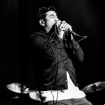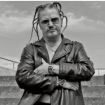For his 2000 album Holy Wood (In the Shadow of the Valley of Death), Marilyn Manson took a Star Wars-ian approach in structuring the record within his existing catalog. Though it was his fourth full-length overall, it would act as the first part of a trilogy that also included the previously released Antichrist Superstar and Mechanical Animals, and like those LPs, it would intertwine elements of fiction with pieces of Manson's real life. Holy Wood drew on traumatic incidents from the singer's youth as well as experiences he had in the wake of the Columbine High School massacre. The murderers were not Manson fans; they preferred KMFDM and Rammstein. Nonetheless, the media latched onto Manson's abrasive music and antisocial messages as major factors that triggered the mass-shooting.
"This story can be interpreted on a number of levels," Manson told Rolling Stone of the album. "But one of the simplest ways is about a boy who wants to become part of the world that he doesn't feel adequate for, and the bitterness and rage becomes a revolution inside him, and what happens is that the revolution becomes just another product. When he realizes it's too late his only choice is to destroy the thing he has created, which is himself."
Unlike Mechanical Animals — which downplayed angst and aggression in favor of decadent yet upbeat compositions heavily influenced by Ziggy Stardust-era David Bowie — Holy Wood (In The Shadow of the Valley of Death) marked a return to the misanthropic industrial metal of Antichrist Superstar. Songs including "The Fight Song," "Disposable Teens," "The Nobodies" and "Burning Flag" were fueled by militant beats, and featured brash and experimental guitar work courtesy of John 5, and Manson's own spiteful vocals that dripped with venom towards an establishment that, in his mind, pushes teenage nonconformists over the edge. Still, the album wasn't all doom and gloom.
"There's a bitterness and a hatred toward a world that's too stupid to accomplish certain things, simple forms of evolution. But there's also hope because I'm not a complete pessimist," Manson told Alternative Press. "And that's a lot of the point of the new record — mankind is predestined to destroy itself. But can we change that? It's in your hands, kids, whatdaya gonna do to change it?"
Decades later, mankind has yet to (fully) destroy itself, and Holy Wood stands as a Manson classic. Here are 10 things you probably didn't know about the album.
1. Marilyn Manson wanted Holy Wood to be his "White Album"
Some of the songwriting and recording for Holy Wood was done in Marilyn Manson's house in the Hollywood Hills, where the Rolling Stones wrote Let it Bleed and filmed Cocksucker Blues, engendering the album with the spirit of the Sixties counterculture. "The end of the Sixties became something I was really obsessed with on this album," Manson told High Times. "I think it was because of the Stones being blamed for Altamont and the Manson murders were a lot like Columbine. [There was] the same media coverage. That's why I started getting into the Beatles' 'White Album' more and more because it was the first record that was blamed for some sort of crime or associated with it. I felt like this had to be our White Album."
2. Teenage rebellion lies at the heart of the Holy Wood
At a time when young Americans were making more of an impact on the world through what they listened to, the video games they played and the ideas they subscribed to, Manson felt that the constant undermining of youth by mainstream society could trigger a full-scale revolution. "I started thinking about the idea that pro-lifers have, where they're trying to determine when a soul begins to exist," he told Alternative Press. "But in Holy Wood, and how I see America now, kids aren't even considered to have souls until they're 18, until they're a valid consumer, until they can vote. They're just pets, almost. Which is why I see this tension and backlash arising with teenagers — you're like, 'Why are these kids acting like this? They have no reason to complain!' Well, it's because you're treating 'em like they're dead. So I'm very impressed with the idea that kids have the opportunity now to genuinely cause a revolution if they want to. Because they are in charge — they just don't know it yet."
3. The way Manson was scapegoated following the Columbine shootings fueled the angry and the subversive vibe of the songs
Being in the crosshair of mainstream America in a way that he had never experienced before was both infuriating and enlightening for Manson, providing him with new insight into the violence that has accompanied pop culture throughout history. "I could say after last year, after the many attacks that came upon me for teenage violence, it gave me a lot of fuel and a lot of anger that I needed to release. I would say anger is a very important state of mind on this record," he told Metal Hammer. "… As far as my mental state of mind, I really put myself in a lot of interesting positions for making this album. There is a lot of experimentation in locations in the deserts, and a lot of thought of Death Valley, and a lot of thought of the assassination of John F. Kennedy in comparison with the crucifixion of Christ, and in comparison with what will be the third and final piece in that sign of trinity that I dreamed up."
4. "Love Song" is about America's romance with guns
With so much anger built up between the end of the prematurely aborted Mechanical Animals tour (which was cut short because of all the death threats Manson received post-Columbine) and the making of Holy Wood, Manson was inspired to craft a song that put his own new spin on gun violence and family values in the U.S. "'The love song' is one of the most common titles in music, and I wanted to make a metaphor about guns, and I was suggesting with the lyrics that the father is the hand, the mother is the gun, and the children are the bullets," Manson told MTV. "Where you shoot them is your responsibility as parents. Because of all of these things swirling around me, I had to figure out a way to express myself, or I was gonna explode."
5. During the album sessions, Manson tracked two classic-rock covers
To accompany import versions of the "Disposable Teens" single," Marilyn Manson recorded covers of the Doors' "Five to One" and John Lennon's "Working Class Hero. "Lennon, Kennedy and Christ are kind of central figures on this album because of the elements of revolution in their lives, and the fact that those who try to change the world end up being changed by the world," Manson told MTV.
5. Manson's substances of choice during the creation of Holy Wood were Soma and absinthe
During the crafting of past Manson albums, cocaine kept the singer and some of his bandmates alert and motivated. With all the energy and aggression that suffused Holy Wood, the singer found the ritual of taking muscle relaxers and the semi-psychedelic spirit absinthe to be more instrumental in opening the doors of creativity. "In the Bible, wormwood [the key ingredient in absinthe] was supposed to be a plant that grew in the path exiting the Garden of Eden, a poison that God sent down to punish mankind," Manson told High Times. "I thought it was something I should try. There is something nice to the ritual as well. Making the album, there were a lot of rituals — whether it was something as simple as absinthe, or just achieving a mindset that took you out of the regular world so that you can concentrate on what you were creating."
"I managed to drink 12 bottles of absinthe, which Van Gogh had drunk when he cut off his ear," he told Metal Hammer. "I didn't cut off an ear, but I think I really wanted to take this one further than I had ever taken anything."
7. Manson's Hollywood Hills home was an entomological nightmare
According to guitarist John 5, Manson's house was always cold and there was always an ominous vibe. He added that while he was there working on Holy Wood, he experienced unnerving encounters with spiders, scorpions and other nasty insects. "[Manson] was living there for a year and a half, and all of a sudden there was a swarm of bees in the kitchen," John 5 told Guitar World. "Thousands of them. You could hear it upstairs. You couldn't even go into the kitchen. [It was] like the Amityville Horror."
8. The band also recorded at the reputedly haunted mansion of Harry Houdini
Once they left Manson's house, the group and co-producer Dave Sardy convened at the Houdini Mansion in Laurel Canyon, which is supposedly haunted. One night, Sardy bumped into somebody behind a curtain that separated two rooms. When he opened the curtain to apologize, no one was there. "I always heard rumors, 'Oh, the house is haunted,'" bassist Twiggy Ramirez told Guitar World." "You say, 'Yeah, right.' I don't know if I believe this, but I heard somebody used to give abortions in that house. So maybe there's a bunch of unborn dead baby ghosts in there. I spent the night there once. And in the morning, I heard people downstairs. I heard someone playing the piano. I thought the crew had arrived … I got up and there was no one down there. Ten minutes later, [someone from the crew] showed up and I asked him if he was playing the piano. He said, 'What are you talking about? I just got here.' So I don't know if he was pulling my leg or if some dead babies were playing the piano."
9. Manson wanted to release two accompanying projects with the record
As he worked on writing and recording, Manson also conceptualized a book and movie that would elaborate on the plot and themes of Holy Wood. "The story is something I really had with me almost seven or eight years ago," he told Metal Hammer. "… So after the record comes out the book will follow and there may, or may not, be a film at some point down the road. There was a point where I was attempting to make the film at the same time as the album. There were plenty of people interested in working with me, but the material was too controversial, both politically and religiously with regards to violence. I spoke with Alexandro Jodorowsky, a hero of mine, and my favorite filmmaker. He and I were going to work together on it." Sadly, for both Manson and Jodorowsky fans, the movie never came to fruition.
10. Holy Wood was banned in Walmart and Kmart, and Circuit City obscured the cover in a cardboard sleeve
The cover art for Holy Wood was co-created by Manson and artist P.R. Brown. It depicts Manson as Christ on the cross. As a commentary on censorship, Manson's jawbone is missing. On the bottom left side of the cover is a fragment of John F. Kennedy's coroner report. Walmart and Kmart refused to sell the album due to the provocative imagery. While the retailers' decision limited sales, Manson seemed happy with the reactions of the corporations. "American people have very poor sense of irony," he told Rock Sound. "I am pleased at the response because my point in showing myself on the cover with my face combined with the statue of Christ is to say that as much as it is entertainment, the image can be seen as violent and sexual and people said it was offensive and censored it — and that proved my point."








